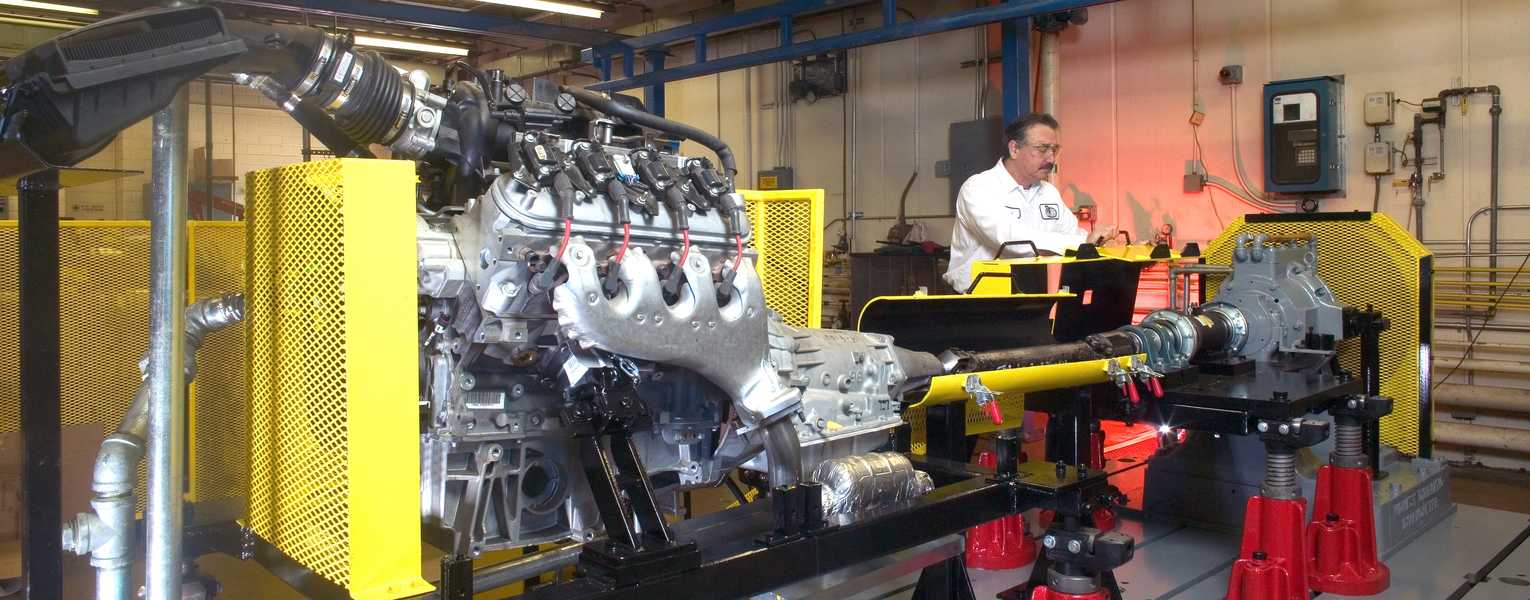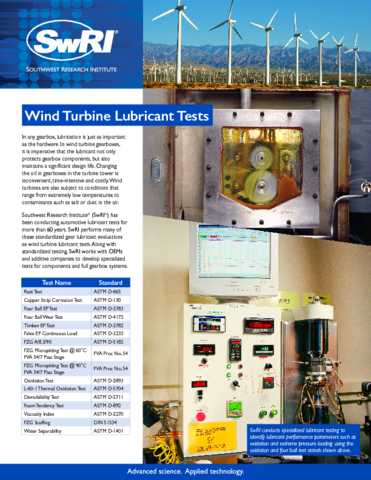We provide standardized and bespoke tests of transmission fluids, gear lubricants, tractor, industrial hydraulic and more. We can also evaluate the components that use these fluids. Standardized protocols include industry standard procedures from SAE International, ASTM International and JASO (Japanese Automotive Standards Organization). These procedures as well as DIN (German Institute for Standardization) and CEC (Coordinating European Council) are used along with many manufacturer testing specifications including those for Allison, Caterpillar, Denison, Eaton, Ford, General Motors, John Deere, Mack, New Holland, Vickers and others.
We provide axle efficiency testing to measure efficiency under a variety of operating temperatures, loads, and rotational speeds. We have special purpose stands to evaluate driveline and component mechanical efficiency. These test stands are capable of discerning small improvements due to fluids, lubricants or component materials and coatings.
We offer complete families of test procedures for each of the following fluid specifications:
Automatic Transmission Fluids
- General Motors DEXRON®-VI, DEXRON®-HP, and DEXRON®-dDCT
- Ford Motor Company MERCON® V, MERCON® LV, and MERCON® ULV
- Allison Transmission TES-439 TM, TES-389 TM, and TES-295TM
- Caterpillar® TO-4, AT-1, and TO-4M
- JASO M348:2012, T903:2016
Manual Transmission and Rear Axle Gear Lubricants Performance Testing
Test types:
Axle efficiency test
SwRI has stands designed and constructed to accept various types of rear-wheel and front-wheel drive axle assemblies. These stands have the capability of programming test procedures/profiles specifically designed by clients.
FZG gear wear test (ASTM D 4998)
To evaluate the anti-wear properties of lubricants, particularly hydraulic fluids for tractors, test gears on the FZG rig are operated at 100 rpm for 20 hours at 121°C (250°F) and load stage 10. The gears are weighed before and after the test and the weight loss associated with wear indicates lubricant anti-wear performance.
FZG load stage test (ASTM D 5182 and CEC L-07-95)
Various speeds, temperatures, etc. are available to evaluate the load-carrying capacity of lubricants. The variable speed FZG test rig runs through a dozen 15-minute stages with incremental increases in load until failure or until the test sequence is complete. Twenty millimeters of tooth scuffing indicate test failure. The FZG Load Stage test method is referenced in API MT-1 (ASTM D5760) and other OEM specifications.
FZG pitting test with Type C gear
This test procedure is used to discriminate different lubricants based upon their ability to prevent pitting, a fatigue failure due to rolling contact. The test consists of a break-in phase and a durability phase. Depending on lubricant viscosity, the durability phase loading will vary. The test normally runs 300 hours and is usually carried out in triplicate to cover outliers.
FZG step load (A10/16.6R/90:120, CEC L-84-02)
This test procedure is for industrial or automotive gear lubricants that exceed the load-carrying capacity of the standard FZG load stage test (A20/8.3/90). The smaller 10 mm wide gears are run in the reverse direction at 2910 rpm through a dozen 7.5-minute stages with incremental increases in load until failure or until the test sequence is complete. The test can run at either 90°C or 120°C (194°F or 248°F). Ten millimeters of tooth scuffing indicates test failure. A pass in load stage nine at 90°C (194°F) indicates GL-5 or better performance.
FZG standard wear test
FZG FVA54 micropitting test
L-20 high-torque test
The L-20 high-torque test determines the load-carrying, wear, and extreme pressure characteristics of gear lubricants under low-speed, high-torque operating conditions. A test axle is operated for30 hours at 32,311 lb.-in. of ring gear torque while the axle lubricant is cycled between 93°C (200°F) and 121°C (250°F). No longer part of U.S. requirements, this procedure has been replaced by L-37, although L-20 is used for some international clients and for screening and research in the United States.
L-33-1 moisture corrosion test (ASTM D 7038)
To determine the corrosion prevention properties of gear lubricants, an axle is filled with 91 ounces of test lubricant and 2.3 ounces of distilled water and operated for four hours at 2,500 rpm and 180°F. After being soaked for 162 hours at 51°C (125°F), the axle is disassembled and rated for rust. The L-33-1 moisture corrosion test, ASTM D 7038, is referred to in FTMS No. 791, MIL-PRF-2105E, SAE J2360, API GL-5 and Federal Test Method 5326.1.
L-37 high-torque test (ASTM D 6121)
To determine the load-carrying, wear, and extreme pressure characteristics of gear lubricants, a test axle is operated under high-speed, low-torque and low-speed, high-torque conditions. A test axle is first operated for 100 minutes at 440 axle rpm, 147.2°C (297°F) lubricant temperature, and 9,460 lb.-in. of ring gear torque and then operated for 24 hours at 80 axle rpm, 135°C (275°F) lubricant temperature and a higher ring gear torque. The L-37 high-torque test, ASTM D 6121, method is referred to in FTMS No. 791, MIL-PRF-2105E, SAE J2360, API GL-5 and Federal Test Method 6507.1.
L-42 high-speed shock axle test (ASTM D7452)
The L-42 high-speed shock axle test, ASTM D 7452, determines a lubricant’s ability to prevent coast-side pinion and ring gear scoring. The axle torque and coast down rates are measured and recorded. This method is referred to in FTMS No. 791, MIL-PRF-2105E, SAE J2360, API GL-5 and Federal Test Method 6507.1.
L-60-1 thermal and oxidative stability test (ASTM D 5704)
The L-60-1 thermal and oxidative stability test method determines lubricant deterioration under severe thermal and oxidative conditions. A set of spur gears is rotated at 1,750 rpm for 50 hours. The lubricant is maintained at 163°C (325°F) with controlled airflow in the presence of a copper catalyst. The physical and chemical properties of the lubricant and deposits on the test gears are evaluated at the end of the test. This method is referred to in FTMS No. 791, MIL-PRF-2105E, SAE J2360, API GL-5, Federal Test Method 2504 and API MT-1 (ASTM D 5760).
Manual transmission high-temperature cyclic durability test (ASTM D 5579)
The high-low range synchronizer of a Mack T2180 transmission is cycled with lubricant temperatures at 121°C (250°F). The shift time is monitored continuously during the test. As the lubricant degrades, the shift time increases. The Manual transmission high-temperature cyclic durability test, ASTM D 5579, continues until two “missed shifts” are reached. This test is part of Mack Trucks, Inc., Gear Oil Specifications GO-H and GO-H/S as well as API MT-1 (ASTM D5760).
SSP 180 synchronizer
The purpose of the SSP 180 synchronizer test is to evaluate the frictional performance of a lubricant in a synchronizer assembly. The test is conducted in an SSP-180 test machine. The synchronizer is loaded by a flywheel that is accelerated and decelerated between rest and top speed. Test conditions are dependent upon the type of synchronizer tested.
Specifications:
- Mack GO-J/J+ and Eaton PS-164 - Mack and Eaton call for modified versions of some axle tests. SwRI can perform the modified Mack GO-J/J+ and Eaton PS-164 tests for these procedures and act as an intermediary for OEM contact when requested.
- Dana SHAES-256
- GM DEXRON® LS Gear Oil 75W-90 (GMW16445)
- GM DEXRON® Gear Oil 75W-90 (GMW16433)
For questions about this testing, please contact Matt Jackson at +1 210 522 6981.



